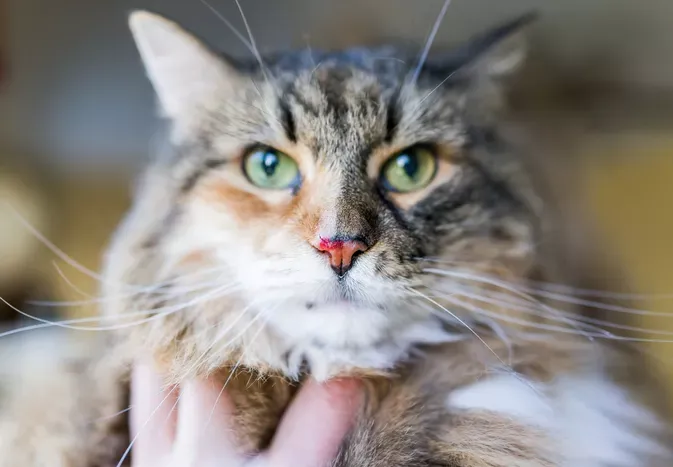Nosebleeds in Cats
Updated on 04/26/24

Nosebleeds in Cats: A Comprehensive Guide for Concerned Cat Owners
Introduction:
Nosebleeds, medically known as epistaxis, are an unexpected and distressing sight for any cat owner. While they can sometimes be a sign of a minor issue, it's crucial to understand the potential causes and symptoms to ensure your feline companion's well-being. This comprehensive guide will delve into the world of nosebleeds in cats, providing expert insights, practical tips, and essential knowledge to help you navigate this concerning condition.
Causes of Nosebleeds in Cats:
* Trauma: Physical injuries, such as a fall or collision, can damage the delicate blood vessels in the nose, leading to bleeding.
* Infections: Bacterial, viral, or parasitic infections can cause inflammation and irritation within the nasal passages, resulting in nosebleeds.
* Blood Clotting Disorders: Inherited or acquired blood clotting disorders can impair the body's ability to form clots, increasing the risk of nosebleeds.
* Tumors: Nasal tumors, either benign or malignant, can exert pressure on surrounding tissues, including blood vessels, causing nosebleeds.
* Foreign Bodies: Objects lodged in the nose, such as grass seeds or small toys, can irritate and damage nasal tissues, leading to bleeding.
Symptoms of Nosebleeds in Cats:
* Visible bleeding from the nose: The most obvious sign of a nosebleed is the discharge of blood from the cat's nostrils.
* Sneezing with blood: Cats may sneeze blood as a reflex to expel irritants or debris from the nose.
* Bloody discharge from the nose: Even after the bleeding has stopped, there may be residual blood discharge for some time.
* Facial swelling: Severe nosebleeds can cause swelling around the nose and eyes due to blood accumulation.
* Pale gums: Excessive blood loss can lead to anemia, causing the gums to appear pale or white.
Immediate Steps When Your Cat Has a Nosebleed:
1. Remain Calm: It's natural to be concerned, but staying composed will help you handle the situation effectively.
2. Hold Your Cat Securely: Gently restrain your cat to prevent them from agitating the nosebleed.
3. Apply Pressure: Using a clean cloth or paper towel, gently apply pressure to the bridge of your cat's nose for 5-10 minutes.
4. Elevate the Head: Tilt your cat's head slightly upward to help reduce blood flow to the nose.
5. Contact Your Veterinarian: Even if the bleeding has stopped, it's essential to contact your veterinarian promptly for further examination.
Treatment of Nosebleeds in Cats:
The treatment for nosebleeds in cats depends on the underlying cause.
* Trauma: For minor injuries, rest and time are often sufficient for healing.
* Infections: Antibiotics, antivirals, or antiparasitics may be prescribed based on the type of infection.
* Blood Clotting Disorders: Medication or blood transfusions may be necessary to manage underlying clotting problems.
* Tumors: Surgical removal or other treatment options may be required depending on the type and size of the tumor.
* Foreign Bodies: Foreign objects will need to be carefully removed by a veterinarian to stop the bleeding.
Prevention of Nosebleeds in Cats:
* Keep Your Cat Indoors: This reduces the risk of traumatic injuries or exposure to infectious agents.
* Provide a Healthy Diet: A balanced diet supports a healthy immune system, reducing the likelihood of infections.
* Regular Veterinary Checkups: Routine exams allow your veterinarian to detect and address any underlying health conditions that may predispose your cat to nosebleeds.
* Avoid Blood Thinners: Certain medications can interfere with blood clotting, so always consult your veterinarian before giving your cat any drugs.
Conclusion:
Nosebleeds in cats can be a concerning occurrence, but by understanding the potential causes, symptoms, and treatment options, you can effectively manage this condition. Remember to remain calm, apply pressure to stop the bleeding, and seek veterinary attention promptly to ensure your cat's well-being. By following the tips outlined in this guide, you can enhance your cat's overall health and reduce the risk of future nosebleeds.
Explore More Pets

Cat Behavior Problems
How to Stop Aggression in Kittens

Long-Haired Cat Breeds
Siberian Cat: Breed Profile, Characteristics, & Care

Cat Behavior Problems
How to Stop Kittens From Scratching and Biting

Long-Haired Cat Breeds
Turkish Angora: Cat Breed Profile, Characteristics & Care

Basic Training
How to Socialize Your Kitten

Short-Haired Cat Breeds
Cute Pictures & Facts About Calico Cats & Kittens

Litter Box Training
Training Your Kitten to Use the Litter Box

Long-Haired Cat Breeds
10 Fun Facts About White Cats